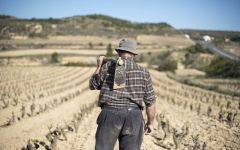Hacienda Lopez de Haro Crianza 2017
-
Wine
Enthusiast



Product Details
Your Rating
Somm Note
Winemaker Notes
#43 of Wine Enthusiast's Top 100 Best Buy of 2020
Hacienda Lopez de Haro is a round, pleasant and expressive wine, made from the Tempranillo, red Garnacha and Graciano grape varieties and aged for more than 2 years in oak and bottle. A wine of intense color and a pleasant bouquet, in which the nuances of mature fruit stand out. In the mouth it is soft, expressive and elegant, combining a fruity character with the notes lent by the cask, in perfect balance.
Professional Ratings
-
Wine Enthusiast
Plum, cherry and earthy spice notes make up a classic Rioja nose, while this crianza from a hot, dry year feels fleshy and ripe. Dark berry flavors push toward the limits of raisiny on the warm finish.
Other Vintages
2020-
Wine
Enthusiast
- Decanter
-
Wilfred
Wong
-
Robert
Parker
-
Robert
Parker








Hacienda López de Haro is the Rioja winery of the Vintae Wine Company and its flagship is the collection of wines with which they pay homage to the authentic essence of their land, Rioja. The place chosen to bring this project to life and to settle the winery could be none other than San Vicente de la Sonsierra, the heart of La Rioja Alta and the area where the best old Tempranillo vineyards are located, thanks to its special climatic characteristics, its orography and its soils.
López de Haro wines are elegant, complex and aromatic and have become the new classics of Rioja. At Hacienda López de Haro, the entire production process is taken care of the tradition. The technical advances and the sustainability are at the service of the artisan elaboration, always with the maximum respect for the Rioja heritage.

Hailed as the star red variety in Spain’s most celebrated wine region, Tempranillo from Rioja, or simply labeled, “Rioja,” produces elegant wines with complex notes of red and black fruit, crushed rock, leather, toast and tobacco, whose best examples are fully capable of decades of improvement in the cellar.
Rioja wines are typically a blend of fruit from its three sub-regions: Rioja Alta, Rioja Alavesa and Rioja Oriental, although specific sub-region (zonas), village (municipios) and vineyard (viñedo singular) wines can now be labeled. Rioja Alta and Alavesa, at the highest elevations, are considered to be the source of the brightest, most elegant fruit, while grapes from the warmer and drier, Rioja Oriental, produce wines with deep color, great body and richness.
